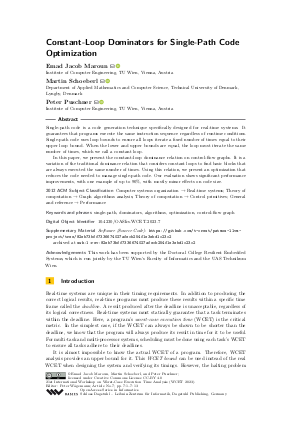@InProceedings{maroun_et_al:OASIcs.WCET.2023.7,
author = {Maroun, Emad Jacob and Schoeberl, Martin and Puschner, Peter},
title = {{Constant-Loop Dominators for Single-Path Code Optimization}},
booktitle = {21th International Workshop on Worst-Case Execution Time Analysis (WCET 2023)},
pages = {7:1--7:13},
series = {Open Access Series in Informatics (OASIcs)},
ISBN = {978-3-95977-293-8},
ISSN = {2190-6807},
year = {2023},
volume = {114},
editor = {W\"{a}gemann, Peter},
publisher = {Schloss Dagstuhl -- Leibniz-Zentrum f{\"u}r Informatik},
address = {Dagstuhl, Germany},
URL = {https://drops.dagstuhl.de/entities/document/10.4230/OASIcs.WCET.2023.7},
URN = {urn:nbn:de:0030-drops-184361},
doi = {10.4230/OASIcs.WCET.2023.7},
annote = {Keywords: single-path, dominators, algorithms, optimization, control-flow graph}
}

 Creative Commons Attribution 4.0 International license
Creative Commons Attribution 4.0 International license




